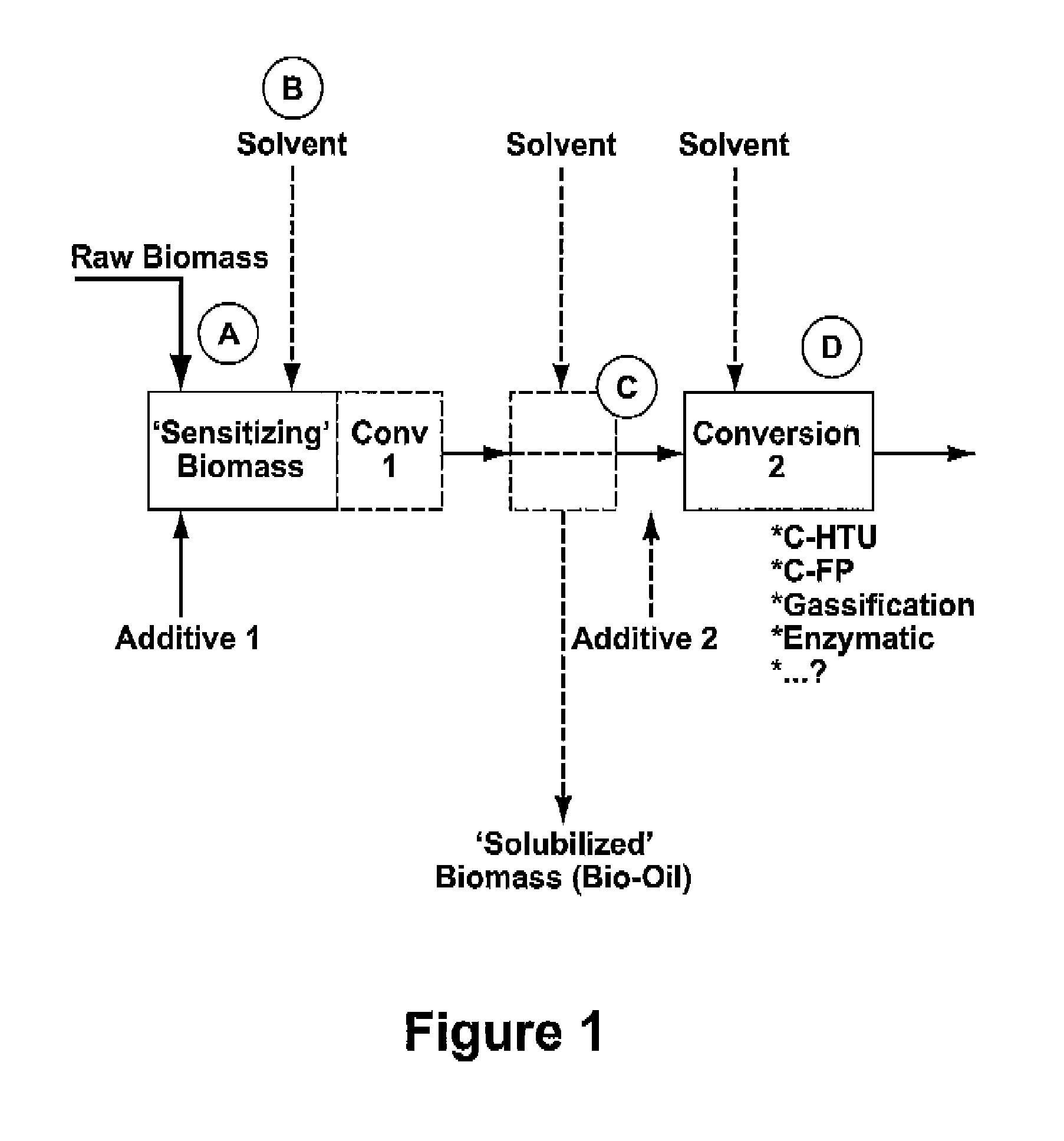Process for the conversion of biomass to liquid fuels and specialty chemicals
a technology of biomass and liquid fuel, applied in the direction of fuels, organic chemistry, combustion gas production, etc., can solve the problems of short life time, difficult operation, and high cost of the process
- Summary
- Abstract
- Description
- Claims
- Application Information
AI Technical Summary
Benefits of technology
Problems solved by technology
Method used
Image
Examples
example 1
[0133]Saw dust was prepared by repeatedly sawing through a piece of construction lumber with a circular saw. Judged by appearance the saw dust particles were predominantly rod-like in shape, and had a mean average larger particle dimension of about 1-2 mm, and a smaller particle dimension of about 0.5 mm.
[0134]Experiments were carried out in 2 mL glass test tubes, able to withstand pressures well in excess of 10 bar. The test tubes were provided with bakelite stoppers, which were equipped with pressure gauges for monitoring the pressure inside the test tubes. The test tubes were provided with magnetic stirrers, and heated in an oil bath. In all experiments the oil bath was kept at 180° C. The pressure inside the test tubes was 10 bar, corresponding with a temperature inside the tubes of 180° C.
[0135]Hydrotalcite (“HTC”) from Aldrich, which is magnesium aluminum hydroxycarbonate of the formula Mg6Al2(CO3)(OH)16. 4H2O, CAS number 11097-59-9, was calcined in air for 1 hour at 650° C.
[0...
example 2
[0144]Biomass material made from White Pine wood milled to an average particle size of 500 micrometers is dispersed in a solution containing Mg(NO3)2 and Al(NO3)3. The Mg / Al mole ratio for this solution is 3. The resulting slurry is stirred for thirty minutes to allow maximum penetration of the solution into the wood particles. The excess solution is drained off and the resulting wet biomass material re-slurried in sodium hydroxide solution such that the final pH is 9 to 10.
[0145]The resulting slurry is divided into two portions. The first portion is aged at 85° C. for six hours. The second portion is aged at 180° C. for one hour.
[0146]The resulting slurries are filtered and dried.
[0147]The presence of a mixture crystalline cellulose and HTC is confirmed by X-ray diffraction in both samples with the higher temperature treatment showing higher crystallinity.
[0148]Thermal decomposition of these samples is performed using a Mettler-Toledo TGA / SDTA851e thermo balance. The samples (10-15...
example 3
[0151]White Pine wood chips are initially pulverized with a mechanical mixer for 5 min to reduce the particle size to about 5 mm. This wood material is wet milled (15 wt % slurry based on weight of wood) along with raw natural magnesite powder (wood to magnesite ratio of 10:2) in a planetary high energy mill (Puverisette 6) for three hours. The slurry is dried at 100° C.
[0152]The presence of the inorganic phase, MgCO3 along with cellulose is confirmed by X-ray diffraction.
[0153]Using the same method described in Example 2 above, the weight loss for the dried wood sample treated with magnesite is about 5 to 10% higher than the untreated wood, while the decomposition of the wood starts at a lower temperature than the untreated wood.
PUM
| Property | Measurement | Unit |
|---|---|---|
| temperature | aaaaa | aaaaa |
| pressure | aaaaa | aaaaa |
| temperatures | aaaaa | aaaaa |
Abstract
Description
Claims
Application Information
 Login to View More
Login to View More - R&D
- Intellectual Property
- Life Sciences
- Materials
- Tech Scout
- Unparalleled Data Quality
- Higher Quality Content
- 60% Fewer Hallucinations
Browse by: Latest US Patents, China's latest patents, Technical Efficacy Thesaurus, Application Domain, Technology Topic, Popular Technical Reports.
© 2025 PatSnap. All rights reserved.Legal|Privacy policy|Modern Slavery Act Transparency Statement|Sitemap|About US| Contact US: help@patsnap.com


